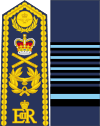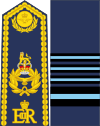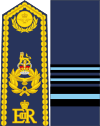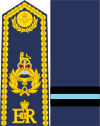Women's Auxiliary Air Force
The Women's Auxiliary Air Force (WAAF), whose members were referred to as WAAFs (/ˈwæfs/), was the female auxiliary of the Royal Air Force during World War II. Established in 1939, WAAF numbers exceeded 180,000 at its peak strength in 1943, with over 2,000 women enlisting per week.
 |
| Royal Air Force air component of the British Armed Forces |
|---|
| Components |
|
| History |
|
|
| Aircraft |
|
| Structure |
| Personnel |
History
A Women's Royal Air Force had existed from 1918 to 1920. The WAAF was created on 28 June 1939, absorbing the forty-eight RAF companies of the Auxiliary Territorial Service which had existed since 1938.[1] Conscription of women did not begin until 1941. It only applied to those between 20 and 30 years of age and they had the choice of the auxiliary services or factory work.

Women recruited into the WAAF were given basic training at one of five sites, though not all of the sites ran training simultaneously. The five sites were at West Drayton, Harrogate, Bridgnorth, Innsworth and Wilmslow.[2] All WAAF basic recruit training was located at Wilmslow from 1943.[3]
WAAFs did not serve as aircrew. The use of women pilots was limited to the Air Transport Auxiliary (ATA), which was civilian. Although they did not participate in active combat, they were exposed to the same dangers as any on the "home front" working at military installations. They were active in parachute packing and the crewing of barrage balloons in addition to performing catering, meteorology, radar, aircraft maintenance, transport, communications duties including wireless telephonic and telegraphic operation. They worked with codes and ciphers, analysed reconnaissance photographs, and performed intelligence operations. WAAFs were a vital presence in the control of aircraft, both in radar stations and iconically as plotters in operation rooms, most notably during the Battle of Britain. These operation rooms directed fighter aircraft against the Luftwaffe, mapping both home and enemy aircraft positions.[4]
Air Force nurses belonged to Princess Mary's Royal Air Force Nursing Service instead. Female medical and dental officers were commissioned into the Royal Air Force and held RAF ranks.
WAAFs were paid two-thirds of the pay of male counterparts in RAF ranks.
By the end of World War II, WAAF enrolment had declined and the effect of demobilisation was to take the vast majority out of the service. The remainder, now only several hundred strong, was renamed the Women's Royal Air Force on 1 February 1949.
Directors

On 1 July 1939, Jane Trefusis Forbes was made Director of WAAF, with the rank of Senior Controller, later, Air Commandant. On 1 January 1943 she was appointed to the rank of Air Chief Commandant with its creation. On 4 October 1943, while Forbes toured Canada, assessing the Royal Canadian Air Force Women's Division, she was relieved by Princess Alice, Duchess of Gloucester, who had been head of the WAAF since 1939, again with the rank of Senior Controller, then, Air Commandant, being gazetted to Air Chief Commandant on 22 March 1943. Forbes retired in August 1944, and the post of director was given to Mary Welsh, who was appointed Air Chief Commandant. After the war, the rank of Air Chief Commandant was suspended and in December 1946, the final director of WAAF, Felicity Hanbury, was appointed.
- Air Chief Commandant Dame Jane Trefusis Forbes, June 1939 – 4 October 1943
- Air Chief Commandant Princess Alice, Duchess of Gloucester, 4 October 1943 – August 1944
- Air Chief Commandant Dame Mary Welsh, August 1944 – November 1946
- Air Commandant Dame Felicity Hanbury, December 1946 – January 1949
Ranks
Initially, the WAAF used the ATS ranking system, although the director held the rank of senior controller (equivalent to brigadier in the British Army and air commodore in the RAF) instead of chief controller (equivalent to major-general or air vice-marshal) as in the ATS. However, in December 1939 the title was changed to air commandant, when the ranks were renamed and reorganised. Other ranks now held identical ranks to male RAF personnel, but officers continued to have a separate rank system, although now different from that of the ATS. From February 1940 it was no longer possible to enter directly as an officer; from that time all officers were appointed from the other ranks. From July 1941 WAAF officers held full commissions. On 1 January 1943, the rank of air chief commandant (equivalent to air vice-marshal) was created with the director's appointment to that rank.
Officers
| NATO code | OF-10 | OF-9 | OF-8 | OF-7 | OF-6 | OF-5 | OF-4 | OF-3 | OF-2 | OF-1 | OF(D) | Student officer | ||||||||||||||||||||||||
|---|---|---|---|---|---|---|---|---|---|---|---|---|---|---|---|---|---|---|---|---|---|---|---|---|---|---|---|---|---|---|---|---|---|---|---|---|
(1939-1940) (Edit) |
No equivalent |
 |
 |
 |
 |
 |
 |
 |
No equivalent | |||||||||||||||||||||||||||
| Senior Controller | Controller | Chief Commandant | Senior Commandant | Company Commander | Deputy Company Commander | Company Assistant | ||||||||||||||||||||||||||||||
(1940-1949)[5] (Edit) |
No equivalent |
 |
 |
 |
 |
 |
 |
 |
 |
No equivalent | ||||||||||||||||||||||||||
| Air Chief Commandant[note 1] | Air Commandant | Group Officer | Wing Officer | Squadron Officer | Flight Officer | Section Officer | Assistant Section Officer | |||||||||||||||||||||||||||||
(Edit) |
 |
 |
 |
 |
 |
No equivalent | ||||||||||||||||||||||||||||||
| Marshal of the RAF | Air chief marshal | Air marshal | Air vice-marshal | Air commodore | Group captain | Wing commander | Squadron leader | Flight lieutenant | Flying officer | Pilot officer /acting pilot officer |
Officer cadet | |||||||||||||||||||||||||
Other ranks
| NATO Code | OR-9 | OR-8 | OR-7 | OR-6 | OR-5 | OR-4 | OR-3 | OR-2 | OR-1 | |||||||||||||||||||||||||||||||
|---|---|---|---|---|---|---|---|---|---|---|---|---|---|---|---|---|---|---|---|---|---|---|---|---|---|---|---|---|---|---|---|---|---|---|---|---|---|---|---|---|
(1939-1940) (Edit) |
No equivalent |
 |
 |
No equivalent | No equivalent | No insignia | No insignia | |||||||||||||||||||||||||||||||||
| Senior Section Leader | Section Leader | Assistant Section Leader | Aircraftwoman 1st Class | Aircraftwoman 2nd Class | ||||||||||||||||||||||||||||||||||||
(1940-1949) (Edit) |
 |
No equivalent |  |
 |
No equivalent | No insignia | No insignia | |||||||||||||||||||||||||||||||||
| Warrant officer[note 2] | Flight Sergeant[note 3] | Sergeant | Corporal | Leading Aircraftwoman | Aircraftwoman 1st Class | Aircraftwoman 2nd Class | ||||||||||||||||||||||||||||||||||
(1939 – 1950) |
 |
No equivalent |  |
 |
No equivalent | No insignia | No insignia | |||||||||||||||||||||||||||||||||
| Warrant officer | Flight sergeant | Sergeant | Corporal | Leading Aircraftman | Aircraftman 1st Class | Aircraftman 2nd Class | ||||||||||||||||||||||||||||||||||
WAAFs serving with SOE
Several members of the WAAF served with the Special Operations Executive during the Second World War.
- Assistant Section Officer Noor Inayat Khan (9901), posthumously Mentioned in Dispatches and awarded the French Croix de Guerre with Gold Star and the George Cross, Britain's highest award for gallantry not in the face of the enemy.[6]
- Section Officer Yvonne Baseden
- Section Officer Yolande Beekman, posthumously awarded the French Croix de Guerre.
- Assistant Section Officer Sonya Butt (9910)
- Section Officer Muriel Byck
- Flight Officer Yvonne Cormeau, awarded the MBE, the Légion d'honneur, Croix de Guerre and Médaille combattant volontaire de la Résistance.
- Flight Officer Alix D'Unienville
- Flight Officer Krystyna Skarbek (aka Christine Granville), awarded the OBE, George Medal and Croix de Guerre.
- Section Officer Mary Katherine Herbert
- Section Officer Phyllis Latour
- Section Officer Cecily Lefort, posthumously awarded the French Croix de Guerre.
- Section Officer Patricia O'Sullivan
- Sergeant Haviva Reik (aka Ada Robinson)
- Assistant Section Officer Lilian Rolfe, posthumously awarded the MBE and the Croix de Guerre.
- Section Officer Diana Rowden, posthumously awarded the MBE and the Croix de Guerre.
- Section Officer Anne-Marie Walters, awarded the MBE.
Flying Nightingales
Nursing Orderlies of the WAAF flew on RAF transport planes to evacuate the wounded from the Normandy battlefields. They were dubbed Flying Nightingales by the press.[7] The RAF Air Ambulance Unit flew under 46 Group Transport Command from RAF Down Ampney, RAF Broadwell, and RAF Blakehill Farm. RAF Dakota aircraft carried military supplies and ammunition so could not display the Red Cross.
Training for air ambulance nursing duties included instruction in the use of oxygen, injections, learning how to deal with certain types of injuries such as broken bones, missing limb cases, head injuries, burns and colostomies; and to learn the effects of air travel and altitude.[8]
In October 2008 the seven nurses still living were presented with lifetime achievement awards by the Duchess of Cornwall.[9]
Gallery
%2C_Wiltshire%2C_showing_WAAF_plotters_and_duty_officers_at_work%2C_1943._CH11887.jpg) The Operations Room at RAF Fighter Command's No. 10 Group Headquarters, Rudloe Manor (RAF Box), Wiltshire, showing WAAF plotters and duty officers at work, 1943
The Operations Room at RAF Fighter Command's No. 10 Group Headquarters, Rudloe Manor (RAF Box), Wiltshire, showing WAAF plotters and duty officers at work, 1943
 WAAF Operation Corona Radio Operators
WAAF Operation Corona Radio Operators Princess Alice, Duchess of Gloucester Commandant of the WAAF
Princess Alice, Duchess of Gloucester Commandant of the WAAF WAAF Barrage Balloon crews at RAF Cardington.
WAAF Barrage Balloon crews at RAF Cardington._repair_and_pack_parachutes_for_use_by_airborne_troops_during_the_Normandy_invasion%2C_31_May_1944._TR1783.jpg) Members of the WAAF repair and pack parachutes for use by airborne troops during the Normandy invasion, 31 May 1944.
Members of the WAAF repair and pack parachutes for use by airborne troops during the Normandy invasion, 31 May 1944. Grave of an Irish WAAF, Clonmacnoise. Cpl Bridget White was serving with the No3 (Pilots) Advanced Flying Unit based at RAF South Cerney when she died in a road accident.[10]
Grave of an Irish WAAF, Clonmacnoise. Cpl Bridget White was serving with the No3 (Pilots) Advanced Flying Unit based at RAF South Cerney when she died in a road accident.[10]
See also
Notes[11]
- created 1943 with first appointment.
- also called Under Officer
- also called Senior Sergeant
References
- Narracot, A.H. (1941). "9 - Woman in Blue". How The R A F Works. Frederick Muller Limited. pp. 108 (n115). Retrieved 30 July 2009.
- Escott, Beryl E. (1989). Women in air force blue : the story of women in the Royal Air Force from 1918 to the present day. Wellingborough: Patrick Stephens Ltd. p. 131. ISBN 9781852600662.
- Pitchfork, Graham (2008). The Royal Air Force day by day. Stroud: Sutton. p. 258. ISBN 9780750943093.
- Eileen Younghusband. One Woman's War. Cardiff. Candy Jar Books. 2011. ISBN 978-0-9566826-2-8
- Talbot-Booth, E.C. (1943). Ranks and Badges in the Navy, Army, RAF and Auxiliaries (PDF). London: George Philip & Son, Ltd. p. 31.
- "No. 38578". The London Gazette (Supplement). 5 April 1949. p. 1703.
- "The Flying Nightingales". RAF Broadwell website. Retrieved 24 October 2008.
- "The Flying Nightingales". Hampshire the County Magazine. Retrieved 24 October 2008.
- Allen, Vanessa (24 October 2008). "Honour at last for the 'Flying Nightingales' who treated 100,000 Second World War troops aboard planes". MailOnline. London. Retrieved 24 October 2008.
- http://members.tripod.com/athlone_graves/athlonecasualtiescornamaghburials/id6.html
- Air Ministry, Women's Auxiliary Air Force: Notes for the Information of Candidates, 5th edition, 1941.
Further reading
- Escott, Beryl, Women in Air Force Blue, Patrick Stephens, 1989. ISBN 1-85260-066-7
- Escott, Beryl, Our Wartime Days, The WAAF in World War II, Sutton Publishing Ltd, 1995. ISBN 0-7509-0638-3
- Escott, Beryl, The WAAF : A History of the Women’s Auxiliary Air Force, Shire Publications, 2003. ISBN 0-7478-0572-5 (also quoted at in context of Czech WAAFs)
- Gane Pushman, Muriel, We All Wore Blue: Experiences in the WAAF, Tempus, 2006. ISBN 978-0-7524-4130-6
- Halsall, Christine, Women of Intelligence. Winning the Second World War with Air Photos, The History Press, 2012. ISBN 978-0-7524-6477-0
- Manning, Mick & Granström, Brita: Taff in the WAAF (English Association Award Winner), Janetta Otter-Barry Books (Frances Lincoln), 2010. ISBN 978-1-84780-093-0
- Rice, Joan, Sand In My Shoes: Coming of Age in the Second World War: Wartime Diaries of a WAAF, Harperpress, 2006. ISBN 0-00-722820-1
- Settle, Mary Lee, All the Brave Promises: The Memories of Aircraft Woman 2nd Class 2146391 (1966)
- Stone, Tessa. "Creating A (Gendered?) Military Identity: The Women's Auxiliary Air Force in Great Britain in the Second World War", Women's History Review, October 1999, Vol. 8, Issue 4, pp. 605–624, scholarly study
- Turner, John Frayn (2011). The WAAF at War. Barnsley, Yorkshire: Pen and Sword Aviation.
- Watkins, Elizabeth, Cypher Officer, Pen Press Publications, Brighton, 2008. ISBN 978-1-906206-27-7 A first-hand account by a young WAAF cypher officer on active duty in the Egypt, Kenya, the Seychelles and Italy in World War II.
- Wyndham J., Love is Blue, Heinemann, 1986. ISBN 0-00-654201-8
- Younghusband, Eileen, Not an Ordinary Life. How Changing Times Brought Historical Events into my Life, Cardiff Centre for Lifelong Learning, Cardiff, 2009. ISBN 978-0-9561156-9-0 (Pages 36–70, 251–55 and 265–67 describe the experiences of a WAAF radar Filterer in World War II.)
- Younghusband, Eileen, One Woman's War, Candy Jar Books, 2011. ISBN 978-0-9566826-2-8
External links
| Wikimedia Commons has media related to Women's Auxiliary Air Force. |
- The WRAF - Women in the Blue: Working through the Second War years—Royal Air Force official website
- The Work of Women in the Women's Auxiliary Air Force, The Second World War Experience Centre, Leeds UK
- "Women as Ground Crews", reproduced from The Aeroplane, No.1686, 17 September 1943
- WAAF Association
- Girlfriends, a musical about WAAFs by Howard Goodall: the website includes research material
- Early Radar Memories; Sgt. Jean (Sally) Semple, one of Britain’s pioneer Radar Operators Retrieved: 22 June 2008
- One Woman's War. Website of former WAAF Officer Eileen Younghusband's latest book 'One Woman's War'.
- Women's Auxiliary Air Force from the IBCC Digital Archive at the University of Lincoln.